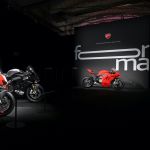
«"Ducati is sophisticated technology and sensual beauty": interview with CEO Claudio Domenicali»: interview with CEO Claudio Domenicali.
«How does the premier Italian motorcycle manufacturer approach designing a racing bike?»
April 17th, 2024
The Design Week has finally begun, and Ducati has managed to secure an important slot in Milan's crowded calendar to showcase the numerous steps involved in the production of a racing motorcycle. We find ourselves at the exhibition Forma - Feelings designed by Ducati in Borgo Panigale, held at the National Museum of Science and Technology Leonardo da Vinci. The exhibition is structured through a journey in seven stages, each representing the fundamental steps by which the designers of Ducati's Style Center and the engineers from the R&D department transform the idea of a motorcycle into a true work of art with sinuous lines, in the full style of the brand. The Ducati model used to illustrate this process is the ultimate supersport in the Borgo Panigale range: the Panigale V4. We have the opportunity to converse with the CEO of Ducati Motor Holding, Claudio Domenicali, a true motorcycling professional who has held this position for more than 10 years.
Ducati has always represented Italian excellence not only in engines and chassis but above all in aesthetics and riding style. How does this combination come about?
«This is the essence of a brand that has evolved over time. It was founded in 1926 and has gone through many historical eras until the mid-1990s when it found its final position with the birth of a very specific product, namely the Ducati 916, an icon of that decade that marked a turning point. That model is even displayed in the 'DNA room' in our museum. It was a product that first brought to life the idea of merging sophisticated technology with sensual beauty. It's not about a trade-off between aesthetics and functionality; the real challenge is to find a blend. Just look at the Panigale V4: a sports bike that represents the pinnacle of performance and technology without sacrificing (in any detail) the beauty of its surfaces.»
What was the most challenging aspect for Ducati in balancing beauty and performance?
«The Panigale V4 was the ultimate challenge. This motorcycle has a very visible feature, namely the absence of the exhaust system. Normally, the exhaust system is prominently displayed, but in this case, we have hidden it under the engine. This unique position makes the design much more complex: Ducati engineers have managed to strike a balance between the sound emissions (remember, the motorcycle must be street-legal and cannot exceed a certain decibel level) without compromising the engine's performance, while staying within the volume standard assigned by the design. When the vehicle is on the road, it exudes a uniqueness derived from our idea of creating exciting forms that do not sacrifice the vehicle's performance.»
What are the most striking differences between designing motorcycles and cars?
«Our style center works daily side by side with the engineering department. We wanted them physically close because, unlike cars, all components of motorcycles are visible. Therefore, an exhaust system or a footpeg plate can be a winning technical element in terms of design, but you have to be very skilled for that to happen; you must infuse the skeletal aesthetics of motorcycles with soul.»
How important is it to have in-house designers rather than relying on external individuals?
«There are very different schools of thought. We prefer to nurture the talent of in-house designers, but I think it also makes sense to work with people outside the company - it brings new creative contributions. However, we made a very clear choice almost 20 years ago: we strongly believe in the idea of having a completely internal design. We believe in the combination of technical engineering and design, and it's very difficult to achieve that if you don't live the company from the inside and breathe the technical and technological complexity of Ducati's products every day. If you're not in the company every day, there's a risk that the forms will drift away from the brand's DNA, and more importantly, become impossible to translate into a truly functional and producible object. Remember that motorcycles must meet a series of honestly complex homologation regulations. Regulations on noise, pollution, braking, and much more; this is why having an internal design school proves successful because there is a need to develop, every day, a sensitivity that can bring to life the blend I mentioned earlier.»
If you could choose an artist to collaborate with on adorning a Ducati motorcycle livery, who would it be?
«Well, that's a very complex question. We are very attentive to ourselves. We try to draw inspiration from everything to advance a highly evolutionary design. We always try to avoid collaborations with external artists or designers because Ducati is a brand with traits of nobility. Therefore, the pursuit of too strong disruptive elements is avoided regardless. To do this, you need to have an excellent knowledge of the past to create a true continuum with the future. Moreover, there is great attention to preserving the concept of Italian sporty style, with soft, elegant, noble surfaces. We must be elegant with monochrome surfaces that do not benefit from graphics or color schemes; we would like the beauty to come from the lines.»
















